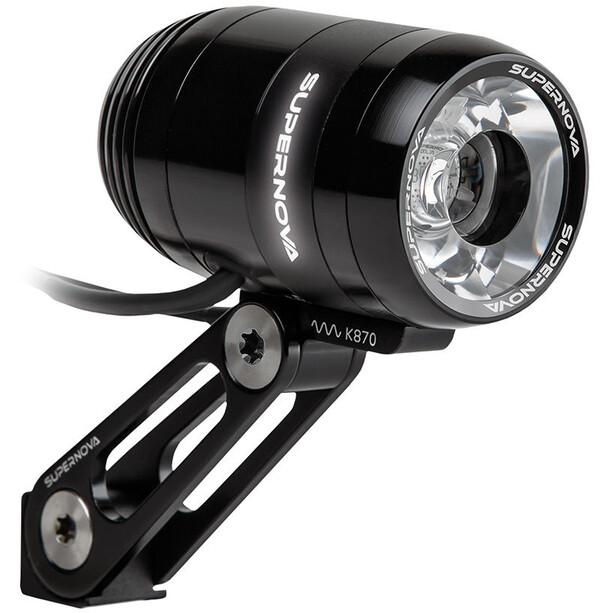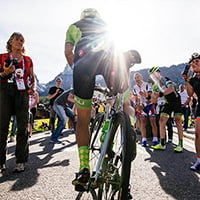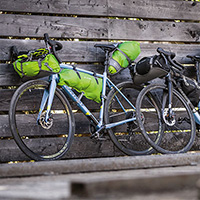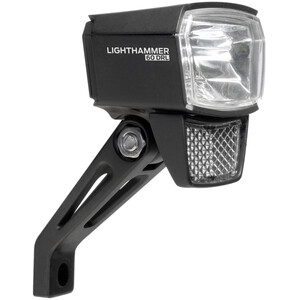Dynamo Bike Lights — The Bright Choice
Dynamo bike lights are a great choice for anyone who's on the go and needs the guaranteed safety of bike lights at all times. Anyone unfamiliar with dynamo lights will love this clever, no-hassle approach to bike lighting. Here at Bikester, we stock a range of battery-powered and dynamo bike lights to ensure you'll always be seen and be riding safely.
E-Bike Displays
"A bicycle dynamo is a small electric generator. It is often simply called a dynamo, but more correctly it is a bicycle alternator. The generator is usually located directly on the wheel and is the energy source for operating the bicycle lights. The dynamo consists of several components. The most important are the impeller, the housing, a round ceramic magnet and the wire coil. From the outside, all you see of the dynamo is the housing and the impeller on top. This is pressed against the rubber casing of the tyre, for example, by a spring. The harder the rider pedals, the faster the wheel turns, and consequently the dynamo. The kinetic energy of pedalling is converted into mechanical energy and then into electrical energy. At normal speed, the voltage of a bicycle dynamo is about six volts and the electrical power about three watts. This is enough to make the headlights and tail lights shine. However, the overall light output depends on the speed transmitted from the wheel to the dynamo.
"
What is a dynamo bike light?
For anyone who's unfamiliar, dynamo bike lights are front and rear LED lights that are powered by a small electricity-generating dynamo that is attached to your bike. Bottle dynamos attach to either the front wheel fork or the bike seat stay. Hub dynamos are built-in to the front wheel hub.
Simply put, the dynamo is a reverse electric motor. It converts the energy created by the rotation of a bike's spinning wheel into electricity. Bottle dynamos have a miniature wheel that rubs against the bike's tyre converting the rotations into electric power. Hub dynamos are more efficient and use magnets to induce electricity in copper coils.
This power that is generated from the bike's constant movement is used to charge front and rear lights. This eliminates the need to charge lights at home in between rides.
Bike lights at Bikester
We know how important reliable lighting is when using your bike, that's why we stock a whole host of different lights and light accessories. Busch & Muller bike lights are a favourite as they offer affordable dynamo options with ultra-bright LEDs. Their innovative diode tail lights have diodes emitting in both directions, ensuring that you're definitely seen on the dark road.
Axa bike lights are a brand that offers the user a series of lights that protect you day and night. Many of their lights include integrated retroreflectors and daylighting which ensure that you're as visible during the day as you are at night. The clear lens technology that they use means you're also visible to people and vehicles approaching you side-ways on.
Battery powered light sets
One downside of dynamo lights is that they slightly increase drag. We also stock a range of battery-powered lights that you might prefer. Often they're USB rechargeable which is both convenient and sustainable, cutting out the use of disposable batteries.
A benefit for some riders to battery-powered vs. dynamo lights is that they're often more lightweight in size and form. You're also able to attach them to any part of your handlebars or rear rack, unrestricted by the wires that dynamo would need.
Battery powered front lights come in a series of designs, such as lamp or spotlight, and often have 360-degree adjustable mounting options. We even offer E-bike compatible lights, which can be used in your E-bike's light port.
Being well-lit, especially in low-light and wet weather conditions, is vital. With sustainable dynamo bike lights you'll never be caught out with flat batteries and no lights. In addition, hub dynamos can also be used to charge a battery pack that, in turn, can be used to recharge your phone, GPS and more.
Dynamo Lights: Frequently Asked Questions



































